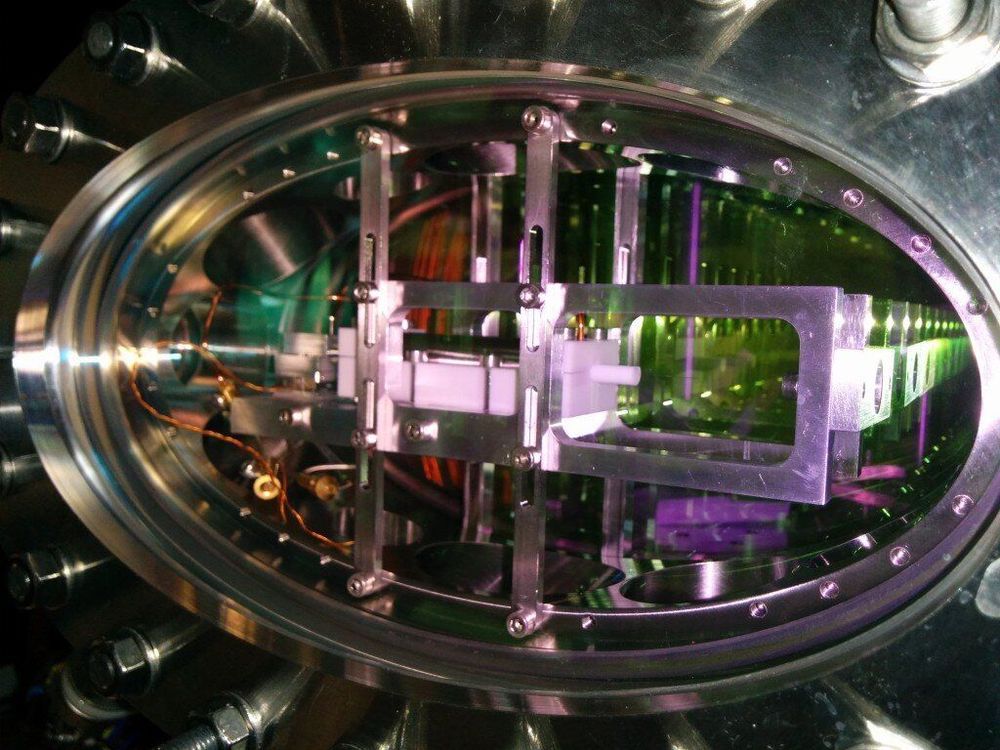After 44 years, there’s finally a better way to find approximate solutions to the notoriously difficult traveling salesperson problem.



“Our goal was to integrate interactive functionalities directly into the fibers of textiles instead of just attaching electronic components to them,” says Jürgen Steimle, computer science professor at Saarland University. In his research group on human-computer interaction at Saarland Informatics Campus, he and his colleagues are investigating how computers and their operation can be integrated as seamlessly as possible into the physical world. This includes the use of electro-interactive materials.
Previous approaches to the production of these textiles are complicated and influence the haptics of the material. The new method makes it possible to convert textiles and garments into e-textiles, without affecting their original properties—they remain thin, stretchable and supple. This creates new options for quick and versatile experimentation with new forms of e-textiles and their integration into IT devices.
“Especially for devices worn on the body, it is important that they restrict movement as little as possible and at the same time can process high-resolution input signals”, explains Paul Strohmeier, one of the initiators of the project and a scientist in Steimle’s research group. To achieve this, the Saarbrücken researchers are using the in-situ polymerization process. Here, the electrical properties are “dyed” into the fabric: a textile is subjected to a chemical reaction in a water bath, known as polymerization, which makes it electrically conductive and sensitive to pressure and stretching, giving it so-called piezoresistive properties. By “dyeing” only certain areas of a textile or polymerizing individual threads, the computer scientists can produce customized e-textiles.

Researchers have developed a new approach to printed electronics which allows ultra-low power electronic devices that could recharge from ambient light or radiofrequency noise. The approach paves the way for low-cost printed electronics that could be seamlessly embedded in everyday objects and environments.
Electronics that consume tiny amounts of power are key for the development of the Internet of Things, in which everyday objects are connected to the internet. Many emerging technologies, from wearables to healthcare devices to smart homes and smart cities, need cost-effective transistors and electronic circuits that can function with minimal energy use.
Printed electronics are a simple and inexpensive way to manufacture electronics that could pave the way for low-cost electronic devices on unconventional substrates—such as clothes, plastic wrap or paper—and provide everyday objects with ‘intelligence’.

A collaboration between researchers from The University of Western Australia and The University of California Merced has provided a new way to measure tiny forces and use them to control objects.
The research, published recently in Nature Physics, was jointly led by Professor Michael Tobar, from UWA’s School of Physics, Mathematics and Computing and Chief Investigator at the Australian Research Council Centre of Excellence for Engineered Quantum Systems and Dr. Jacob Pate from the University of Merced.
Professor Tobar said that the result allowed a new way to manipulate and control macroscopic objects in a non-contacting way, allowing enhanced sensitivity without adding loss.

A team of physicists led by Professor Patrick Windpassinger at Johannes Gutenberg University Mainz (JGU) has successfully transported light stored in a quantum memory over a distance of 1.2 millimeters. They have demonstrated that the controlled transport process and its dynamics has only little impact on the properties of the stored light. The researchers used ultra-cold rubidium-87 atoms as a storage medium for the light as to achieve a high level of storage efficiency and a long lifetime.
“We stored the light by putting it in a suitcase so to speak, only that in our case the suitcase was made of a cloud of cold atoms. We moved this suitcase over a short distance and then took the light out again. This is very interesting not only for physics in general, but also for quantum communication, because light is not very easy to ‘capture’, and if you want to transport it elsewhere in a controlled manner, it usually ends up being lost,” said Professor Patrick Windpassinger, explaining the complicated process.
The controlled manipulation and storage of quantum information as well as the ability to retrieve it are essential prerequisites for achieving advances in quantum communication and for performing corresponding computer operations in the quantum world. Optical quantum memories, which allow for the storage and on-demand retrieval of quantum information carried by light, are essential for scalable quantum communication networks. For instance, they can represent important building blocks of quantum repeaters or tools in linear quantum computing. In recent years, ensembles of atoms have proven to be media well suited for storing and retrieving optical quantum information. Using a technique known as electromagnetically induced transparency (EIT), incident light pulses can be trapped and coherently mapped to create a collective excitation of the storage atoms. Since the process is largely reversible, the light can then be retrieved again with high efficiency.

Could make awesome computers.
Materials scientists who work with nano-sized components have developed ways of working with their vanishingly small materials. But what if you could get your components to assemble themselves into different structures without actually handling them at all?
Verner Håkonsen works with cubes so tiny that nearly 5 billion of them could fit on a pinhead.
He cooks up the cubes in the NTNU NanoLab, in a weird-looking glass flask with three necks on the top using a mixture of chemicals and special soap.


The blockchain revolution, online gaming and virtual reality are powerful new technologies that promise to change our online experience. After summarizing advances in these hot technologies, we use the collective intelligence of our TechCast Experts to forecast the coming Internet that is likely to emerge from their application.
Here’s what learned:
Security May Arrive About 2027 We found a sharp division of opinion, with roughly half of our experts thinking there is little or no chance that the Internet would become secure — and the other half thinks there is about a 60% probability that blockchain and quantum cryptography will solve the problem at about 2027. After noting the success of Gilder’s previous forecasts, we tend to accept those who agree with Gilder.
Decentralization Likely About 2028–2030 We find some consensus around a 60% Probability and Most Likely Year About 2028–2030. The critical technologies are thought to focus on blockchain, but quantum, AI, biometrics and the Internet of things (IoT) also thought to offer localizing capabilities.

Physics theory suggests that exotic excitations can exist in the form of bound states confined in the proximity of topological defects, for instance, in the case of Majorana zero modes that are trapped in vortices within topological superconducting materials. Better understanding these states could aid the development of new computational tools, including quantum technologies.
One phenomenon that has attracted attention over the past few years is “braiding,” which occurs when electrons in particular states (i.e., Majorana fermions) are braided with one another. Some physicists have theorized that this phenomenon could enable the development of a new type of quantum technology, namely topological quantum computers.
Researchers at Pennsylvania State University, University of California-Berkeley, Iowa State University, University of Pittsburgh, and Boston University have recently tested the hypothesis that braiding also occurs in particles other than electrons, such as photons (i.e., particles of light). In a paper published in Nature Physics, they present the first experimental demonstration of braiding using photonic topological zero modes.

The U.S. Defense Intelligence Agency awarded nearly $800 million in contacts to two major defense contractors to improve data storage and network modernization.
The DIA, a military intelligence agency, chose Northrop Grumman to deliver its Transforming All-Source Analysis with Location-Based Object Services (TALOS) program, which focuses on building new big data systems. The contract is worth $690 million. A spokesperson for Northrop Grumman declined to provide the performance period.
The DIA made two awards to Northrop Grumman and GDIT.